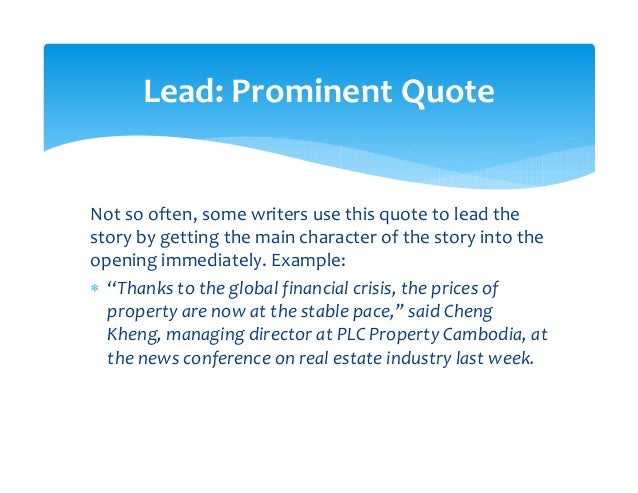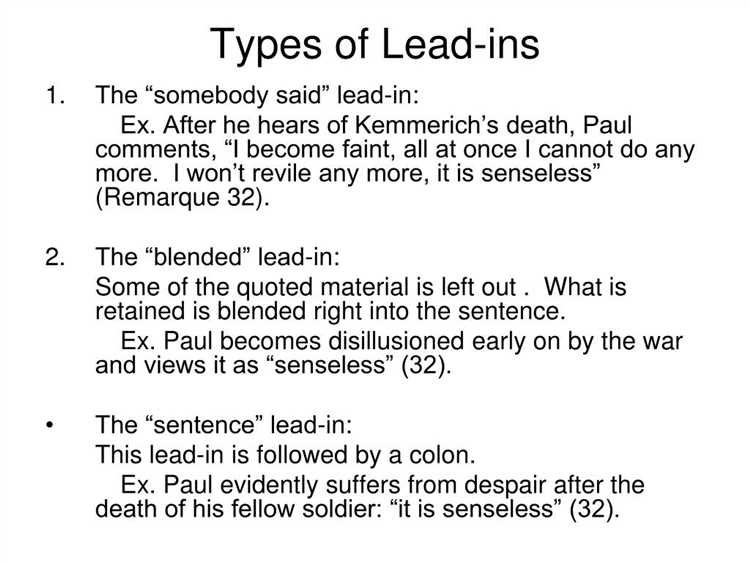Quotations are a powerful tool for capturing readers’ attention and adding credibility to your writing. However, a great quote alone is not enough to engage your audience. To truly captivate your readers, you need a compelling lead-in to your quote. A well-crafted lead-in will pique curiosity, create context, and set the stage for the impactful words that follow.
First and foremost, your lead-in should be concise and attention-grabbing. It should provide a brief summary or teaser of the quote’s content, giving readers a taste of what to expect. By enticing your audience with an intriguing lead-in, you increase the chances that they will continue reading to discover the full quote.
Additionally, consider using strong language or vivid imagery in your lead-in to create an emotional connection with your readers. Powerfully evoking an emotion or painting a picture in their minds will make your lead-in more memorable and resonate with your audience on a deeper level.
Furthermore, it’s important to provide context for your quote within your lead-in. This can involve briefly explaining the background or significance of the quote, or highlighting the expertise or authority of the person being quoted. By providing context, you help your readers understand the relevance and importance of the quote, making it more persuasive and impactful.
In conclusion, writing a captivating lead-in for a quote involves capturing your readers’ attention, enticing them with an intriguing summary, evoking emotions or creating a vivid image, and providing necessary context. By mastering the art of crafting an engaging lead-in, you can effectively leverage the power of quotations to enhance your writing and captivate your audience.
Using Thought-Provoking Statements
One effective way to write a captivating lead-in for a quote is by using thought-provoking statements. These statements grab the reader’s attention and make them curious to know more about the quote that follows.
Why use thought-provoking statements?
Thought-provoking statements create intrigue and engage the reader right from the beginning. They make the reader think, question, and desire to learn more about the topic. By using a thought-provoking statement as a lead-in for a quote, you can pique the reader’s interest and make them eager to discover the insights provided in the quote itself.
Examples of thought-provoking statements:
- “The greatest danger for most of us is not that our aim is too high and we miss it, but that it is too low and we reach it.” – Michelangelo
- “If you want to achieve greatness, stop asking for permission.” – Anonymous
- “We are what we repeatedly do. Excellence, then, is not an act, but a habit.” – Aristotle
How to incorporate thought-provoking statements into your writing:
- Start with a powerful and attention-grabbing statement.
- Make sure the statement is relevant to the topic or subject of the quote.
- Use evocative language and vivid imagery to make the statement more engaging.
- Keep the statement concise and to the point.
- Lead smoothly into the quote by bridging the gap between the thought-provoking statement and the quote itself.
Benefits of using thought-provoking statements:
- Creates curiosity and intrigue.
- Engages the reader from the start.
- Provides a unique perspective or point of view.
- Encourages deeper thinking and reflection.
- Improves the overall readability and impact of your writing.
Incorporating thought-provoking statements into your lead-ins for quotes can significantly enhance the effectiveness of your writing. By grabbing the reader’s attention and sparking their curiosity, you can make your quotes more impactful and memorable.
Incorporating Emotional Appeal
When it comes to writing a captivating lead-in for a quote, one effective technique is to incorporate emotional appeal. By tapping into the reader’s emotions, you can create a powerful and engaging introduction that draws them in and makes them eager to read the rest of the quote.
Here are some strategies you can use to incorporate emotional appeal in your lead-in:
- Use vivid language: Describe the emotions experienced by the person being quoted using vivid and descriptive language. This will help the reader to empathize with the speaker and feel a connection to their experience.
- Share personal anecdotes: If applicable, share a personal story or anecdote that relates to the quote. This can create an emotional connection with the reader and make the quote more relatable and impactful.
- Highlight the significance: Explain why the quote is important and how it relates to the reader’s own experiences or emotions. This can make the quote feel more relevant and emotionally resonant.
- Include statistics or facts: If there are relevant statistics or facts that support the emotional appeal of the quote, include them in your lead-in. This can help to strengthen the emotional impact and make the quote more persuasive.
- Use rhetorical questions: Ask thought-provoking questions that elicit an emotional response. This can create a sense of anticipation and curiosity in the reader, compelling them to continue reading to find out the answer.
- Set the tone: Use tone words and descriptive language to set the emotional tone of the quote. This can give the reader a preview of the emotions they can expect to encounter in the quote itself.
By incorporating emotional appeal in your lead-in, you can make your quote more engaging and compelling. Remember to consider your target audience and the emotions you want to evoke, and choose the techniques that are most appropriate for your specific quote.
Highlighting the Speaker’s Expertise
When including a quote in your writing, it’s important to consider the expertise and credibility of the speaker. By highlighting the speaker’s expertise, you not only establish their authority on the topic, but also make the quote more impactful and persuasive.
Here are some effective ways to highlight the speaker’s expertise:
1. Provide Background Information
Introduce the speaker by providing relevant background information that establishes their expertise in the subject matter. This could include their qualifications, experience, or notable achievements. For example:
- Dr. Jane Smith, a renowned psychologist and author, who has studied the effects of stress on mental health for over two decades, emphasizes the importance of self-care.
- John Doe, a successful entrepreneur and business strategist, advises aspiring entrepreneurs to focus on creating a unique value proposition that sets their business apart.
2. Mention Professional Affiliations
Highlight any professional affiliations or memberships that the speaker has which enhance their credibility. This could include memberships in industry organizations or their involvement in relevant research groups. For example:
- Sarah Johnson, a member of the American Medical Association, stresses the importance of regular exercise in maintaining a healthy lifestyle.
- Professor David Williams, a leading expert in environmental science and a researcher at the National Institute of Environmental Studies, warns of the long-term consequences of climate change.
3. Reference Notable Publications
If the speaker has published books, articles, or research papers on the topic, reference these works to further establish their expertise. This adds credibility to their opinions and strengthens the impact of the quote. For example:
- In her groundbreaking book “The Power of Positive Thinking,” Dr. Emily Adams explores the connection between a positive mindset and overall well-being.
- According to a recent study by Dr. Michael Watson and his colleagues, incorporating mindfulness practices into daily routines can significantly reduce stress levels.
4. Include Notable Achievements
If the speaker has achieved notable recognition or accomplishments in the field, highlight these achievements to emphasize their expertise. This could include awards, certifications, or significant contributions to the industry. For example:
- Professor Lisa Young, recipient of the Nobel Prize in Chemistry, advocates for environmentally friendly alternatives to traditional energy sources.
- Chris Johnson, a certified financial planner with over 20 years of experience, advises investors on building a diverse portfolio to maximize returns.
By incorporating these strategies, you can effectively highlight the speaker’s expertise when introducing a quote. This not only adds credibility to your writing but also captures the attention of your readers and makes the quote more impactful.
Creating Visual Imagery
In writing, the use of visual imagery is a powerful tool to engage readers and bring ideas to life. By painting a vivid picture in the reader’s mind, visual imagery can make a quote more memorable and impactful. Here are some techniques to create visual imagery in your writing:
- Metaphors and Similes: Comparing one thing to another can help create visual imagery. For example, “Her smile was as bright as the sun” paints a picture of a radiant smile.
- Specific Details: Including specific details in a quote can make it more visual. Instead of saying, “The dog was big,” you can say, “The dog was the size of a small horse.”
- Sensory Language: Describing what something looks, sounds, tastes, smells, or feels like can help readers visualize the quote. For example, “The air was crisp and filled with the scent of freshly baked bread.”
- Contrast: Contrasting two things can create a visual image. For instance, “The skyscrapers towered over the old, crumbling buildings like giants among ants.”
- Active Verbs: Using active verbs instead of passive verbs can make a quote more dynamic and visual. For instance, “The waves crashed against the rocks” is more visual than “The rocks were hit by the waves.”
By incorporating these techniques, you can create captivating lead-ins for quotes that are not only informative but also visually appealing. Remember to use visual imagery strategically and sparingly, as too much can overwhelm the reader.
Adding a Personal Touch
When it comes to incorporating quotes into your writing, adding a personal touch can make a significant impact on your readers. By including a personal anecdote, reflection, or connection to the quote, you can create a more engaging lead-in and establish a stronger connection with your audience.
1. Share a personal experience:
Introducing a quote by sharing a personal experience that relates to the quote can help make it more relatable and memorable for your readers. For example:
- “I vividly remember the moment when I first heard the quote, ‘Life is like riding a bicycle. To keep your balance, you must keep moving.’ These words resonated with me deeply, as I was going through a challenging period in my life, and they served as a constant reminder to keep pushing forward.”
2. Reflect on the quote’s meaning:
Taking a moment to reflect on the deeper meaning of the quote can add depth and insight to your lead-in. Consider the following example:
- “As I pondered over the quote, ‘The only way to do great work is to love what you do,’ I couldn’t help but question my own passion and dedication towards my career. It made me realize the importance of finding joy and fulfillment in my work, and it inspired me to make the necessary changes to align my career with my passions.”
3. Make a personal connection to the quote:
Connecting the quote to your personal beliefs, values, or experiences can create a powerful lead-in. Here’s an example:
- “As someone who has always valued honesty and integrity, the quote, ‘The best way to predict your future is to create it,’ deeply resonates with me. It reminds me that I have the power to shape my own destiny by making conscious choices and taking proactive steps towards my goals.”
By adding a personal touch to your lead-ins, you can bring quotes to life and make them more impactful for your readers. Remember to choose anecdotes, reflections, or connections that are relevant to your topic and audience, and craft your lead-ins with care to create a captivating introduction to your quotes.
Emphasizing the Relevance
When including a quote in your writing, it is important to make sure that it is relevant and adds value to your argument or discussion. Emphasizing the relevance of the quote can help your readers understand why it is important and why they should pay attention.
Here are some ways to emphasize the relevance of a quote:
- Provide context: Before introducing the quote, give your readers some background information to help them understand why the quote is relevant to the topic being discussed. This can be done by briefly summarizing the main points or ideas that will be discussed in the quote.
- Highlight key words or phrases: If there are specific words or phrases in the quote that are especially relevant to your argument, highlight or bold them to draw attention. This can help your readers focus on the most important aspects of the quote.
- Explain the connection: After including the quote, take the time to explain how it is connected to your argument or discussion. This can be done by analyzing the quote and discussing how it supports or contradicts your own ideas.
By emphasizing the relevance of a quote, you can help your readers understand its importance and how it contributes to the overall message of your writing. This can make your writing more persuasive and engaging, helping to captivate your audience.
Ending with a Call to Action
When using a quote as a lead-in, it is important to end the introduction with a strong call to action to encourage readers to continue reading and engage with the content.
Here are some effective ways to end your lead-in with a call to action:
- Ask a question: Pose a thought-provoking question related to the quote. This will pique the reader’s curiosity and encourage them to read further to find the answer.
- Make a statement: End with a strong statement that emphasizes the importance or relevance of the quote. This will leave readers wanting to know more and encourages them to read on.
- Provide a recommendation: Suggest further reading or additional resources related to the quote. This shows that you have more to offer and encourages readers to continue exploring the topic.
Remember, the call to action should be clear and concise. It should motivate readers to take the next step and engage with the content, whether it’s reading the full article, leaving a comment, or sharing it with others.
| Example: |
|---|
| “As Albert Einstein once said, ‘Imagination is more important than knowledge.’ But how can we tap into our imaginations and unlock our creative potential? Read on to discover practical tips and strategies for nurturing your creativity and embracing the power of imagination. Are you ready to unleash your inner artist?” |
In this example, the lead-in ends with a call to action that challenges readers to unleash their inner artist. This creates a sense of excitement and adventure, enticing readers to continue reading and explore the possibilities of tapping into their imagination.
By ending your lead-in with a compelling call to action, you can captivate readers and encourage them to dive deeper into the content associated with the quote.
Question and answer:
What is a lead-in for a quote?
A lead-in for a quote is a brief introduction or sentence that precedes a quote, helping to set the context or provide additional information before the quote is presented.
Why is a captivating lead-in important for a quote?
A captivating lead-in is important for a quote because it grabs the reader’s attention and encourages them to continue reading. It helps to create a smooth transition between the lead-in and the quote itself, making the quote more impactful and meaningful.
What are some tips for writing a captivating lead-in for a quote?
There are several tips for writing a captivating lead-in for a quote. Firstly, consider using a provocative or thought-provoking statement that sparks curiosity. Secondly, provide relevant background information or context to help the reader understand the quote better. Lastly, use descriptive language or a strong verb to create a vivid image or emotional response.
Can you provide an example of a captivating lead-in for a quote?
Sure! Here’s an example: “In the midst of chaos and uncertainty, Albert Einstein once said, ‘Imagination is more important than knowledge.’ These words continue to resonate with us today, reminding us to embrace the power of imagination in finding solutions to the most complex problems.”
What are some common mistakes to avoid when writing a lead-in for a quote?
One common mistake is using clichéd or overused phrases that don’t capture the reader’s attention. Another mistake is providing too much information or summarizing the quote in the lead-in, which takes away the impact of the quote itself.
How can I make my lead-in more engaging?
To make your lead-in more engaging, consider using storytelling techniques, such as opening with an anecdote or personal experience. You can also ask a thought-provoking question or present a surprising fact to pique the reader’s curiosity. Additionally, using vivid language or creating a sense of urgency can make the lead-in more compelling.


